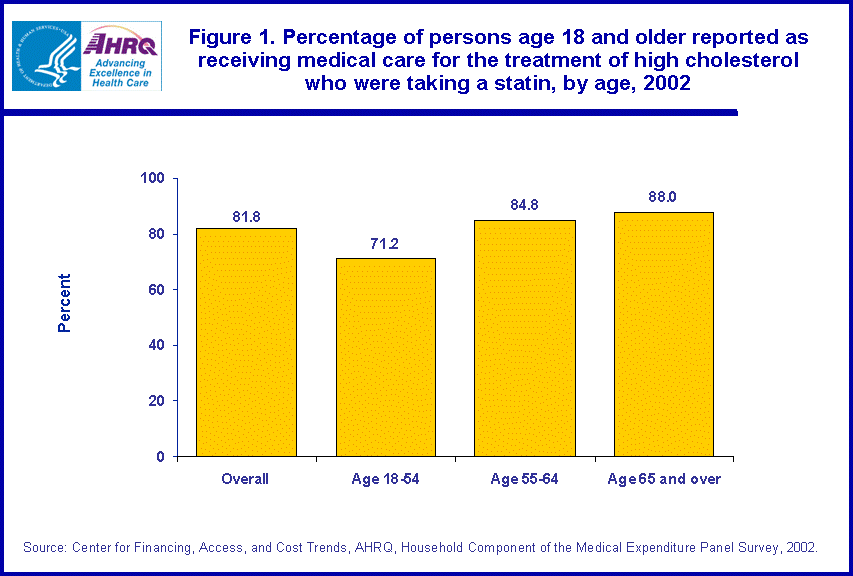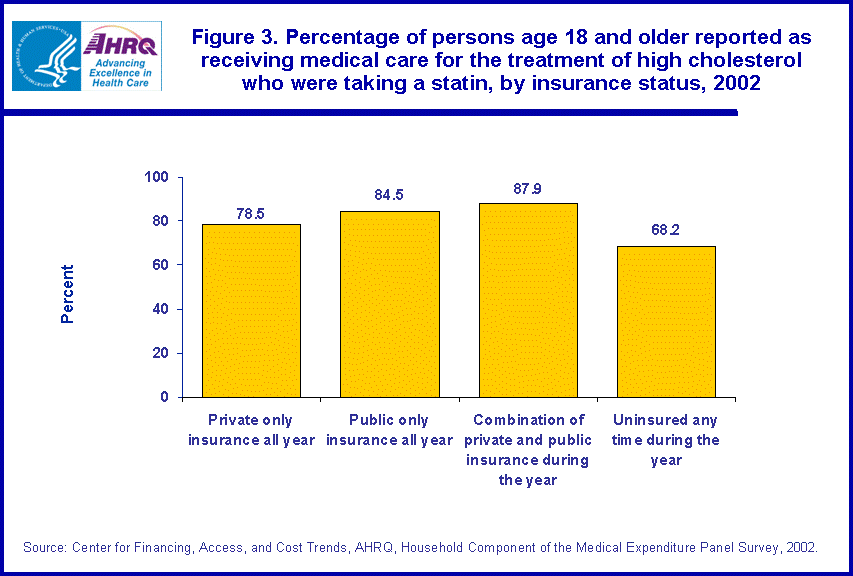
|
|
Font Size:
|
||||
|
|
|
|
||||
STATISTICAL BRIEF #95:
Statin Use among Persons 18 and Older in the U.S. Civilian Noninstitutionalized Population Reported as Receiving Medical Care for the Treatment of High Cholesterol, 2002
Highlights
- During 2002, 81.8 percent of the 19.4 million persons 18 and older in the U.S. civilian noninstitutionalized population receiving medical care for the treatment of high cholesterol were using a statin.
- The percentage of persons with a medical event related to high cholesterol who were taking a statin was 88.0 percent for those age 65 and older and 84.8 percent for those age 55-64, both higher than the 71.2 percent for persons age 18-54.
- Of all persons 18 and older with a medical event related to the treatment of high cholesterol, a smaller percentage of Hispanics were taking a statin (70.0 percent) than white non-Hispanics single race (82.3 percent) and black non-Hispanics single race (85.8 percent).
- The percentage of persons 18 and older under care for the treatment of high cholesterol who were taking a statin was higher for those with health insurance coverage the entire year than for those uninsured at some point during the year.
- In 2002, no significant differences were noted among persons receiving medical care to treat high cholesterol who were using a statin when comparing by gender, education status, poverty status, health status, region, and metropolitan statistical area status.
Introduction
This Statistical Brief seeks to inform policymakers of subgroups of the U.S. civilian noninstitutionalized population who used statins for the treatment of high cholesterol in 2002. Estimates of persons with high cholesterol who were using a statin are compared for selected demographic and socioeconomic characteristics, including age, race/ethnicity, and insurance status.
The data used to produce the estimates in this brief are derived from the Household Component of the Medical Expenditure Panel Survey (MEPS-HC) for 2002. Data used to classify persons as to whether they had high cholesterol and whether they were taking a statin are based on information obtained from MEPS-HC respondents, who provided data for all members of their household, and the Multum Lexicon database. Persons with at least one reported medical event related to the treatment of high cholesterol were included in the analyses, and a person had to report at least one prescribed medicine purchase of a statin to be classified as a statin user. Free samples are not included in these estimates. Results discussed are statistically significant at the .05 level.
Findings
In 2002, among the 19.4 million persons age 18 and older in the U.S. civilian noninstitutionalized population receiving medical care for treatment of high cholesterol, 81.8 percent were using a statin. (figure 1)
During 2002, the percentage of persons age 65 and older with a medical event related to high cholesterol who were taking a statin was nearly 90 percent (88.0 percent). The 71.2 percent of those age 18-54 receiving care for high cholesterol who were taking a statin was lower than the 88.0 percent of persons age 65 and older and the 84.8 percent of those persons age 55-64. (figure 1)
The percentage of Hispanics receiving treatment for high cholesterol who were taking a statin (70.0 percent) was less than the comparable percentage for white non-Hispanics single race (82.3 percent) and black non-Hispanics single race (85.8 percent) in 2002. (figure 2)
In 2002, among those under medical care for the treatment of high cholesterol, those with health insurance coverage all year had a higher percentage of persons taking a statin than those who were uninsured for all or part of the year. More specifically, there was a higher percentage of persons with private insurance only all year (78.5 percent), public insurance only all year (84.5 percent), and a combination of public and private insurance during the year (87.9 percent) receiving treatment for high cholesterol who were taking a statin compared to those who were uninsured at any time during the year (68.2 percent). In addition, those with private insurance only all year (78.5 percent) had a lower percentage of persons under treatment for high cholesterol who were taking a statin than those with public insurance only all year (84.5 percent) and those with a combination of public and private insurance during the year (87.9 percent). (figure 3)
In 2002, no statistical differences were noted among persons receiving medical care for the treatment of high cholesterol who were taking a statin by gender, education status, poverty status, health status, region, and metropolitan statistical area status.
Data Source
The estimates presented in this Statistical Brief were derived from the 2002 MEPS full-year files and the 2002 MEPS prescribed medicines (PMED) files. Statins were identified by linking the PMED files to the Multum Lexicon. Individuals were classified as using statins if they had one or more purchases of these drugs during the year.
Definitions
Use
Use was defined as one or more purchases of a prescribed statin medicine. The group of drugs commonly known as statins is more formally referred to as 3-hydroxy-3-methylglutaryl coenzyme A (HMG-CoA) reductase inhibitors.* This brief focuses solely on this class of drugs. Other cholesterol-lowering drugs, such as fibric acid derivatives and bile acid sequestraints, were not included. For this brief, statins were determined by using the Multum Lexicon therapeutic classification variables from Cerner Multum, Inc. Statins were defined as those prescribed drugs in the Multum Lexicon therapeutic sub-class, HMG-CoA Reductase Inhibitors.
Conditions in MEPS
Conditions in MEPS are household-reported conditions that are coded by professional medical coders using the International Classification of Diseases, Ninth Revision (ICD-9). Condition categories were aggregated into clinically meaningful categories by using AHRQ's Clinical Classification Software (CCS). The CCS code representing high cholesterol is 053. Persons were included in the high cholesterol population if it was reported that they had at least one medical event in 2002 that was for the treatment of high cholesterol. If a person was reported to have more than one condition related to a medical event but at least one of the conditions was high cholesterol, the person was included in the analyses.
Age
Age was usually based on the sample person's age at the end of the year. If the person was not in the survey at the end of the year, then age at the time he or she was last in the survey was used.
Racial and ethnic classifications
Classification by race and ethnicity was based on information reported for each family member. Respondents were asked if each family member's race was best described as American Indian, Alaska Native, Asian or Pacific Islander, black, white, or other. They also were asked if each family member's main national origin or ancestry was Puerto Rican; Cuban; Mexican, Mexicano, Mexican American, or Chicano; other Latin American; or other Spanish. All persons whose main national origin or ancestry was reported in one of these Hispanic groups, regardless of racial background, were classified as Hispanic. Since the Hispanic grouping can include black Hispanic, white Hispanic, Asian and Pacific Islanders Hispanic, and other Hispanic, the race categories of black, white, Asian and Pacific Islanders, and other do not include Hispanic. Beginning in 2002, MEPS respondents were allowed to report multiple races, and these persons were included in the other non-Hispanic category. As a result, there was a slight increase in the percentage of persons classified in this category in 2002 compared with prior years.
Health insurance status
- Private only coverage all year: Private health insurance coverage was defined as nonpublic insurance that provided coverage for hospital and physician care (including Medigap coverage). People in this category had this type of insurance only for all 12 months of the year.
- Public only coverage all year: People were considered to have public only health insurance coverage if they were not covered by private insurance, and they were covered by Medicare, Medicaid, TRICARE, or other public hospital and physician coverage for all twelve months of the year.
- Uninsured any time during the year: People who lacked coverage for at least one month during the year were classified in the uninsured any time during the year category. People who were covered only by noncomprehensive State-specific programs (e.g., Maryland Kidney Disease Program) or private single service plans (e.g., coverage for dental or vision care only, coverage for accidents or specific diseases) were considered to be uninsured.
- Combination of private and public insurance during the year: People who had a mix of private and public health insurance coverage during the year were included in this category. People in this category were not uninsured at any time during the year.
About MEPS-HC
MEPS-HC is a nationally representative longitudinal survey that collects detailed information on health care utilization and expenditures, health insurance, and health status, as well as a wide variety of social, demographic, and economic characteristics for the civilian noninstitutionalized population. It is cosponsored by the Agency for Healthcare Research and Quality and the National Center for Health Statistics.
For more information about MEPS, call the MEPS information coordinator at AHRQ (301-427-1656) or visit the MEPS Web site at http://www.meps.ahrq.gov/.
References
For a detailed description of the MEPS survey design, sample design, and methods used to minimize sources of nonsampling error, see the following publications:
Cohen, J. Design and Methods of the Medical Expenditure Panel Survey Household Component. MEPS Methodology Report No. 1. AHCPR Pub. No. 97-0026. Rockville, Md.: Agency for Health Care Policy and Research, 1997.
Cohen, S. Sample Design of the 1996 Medical Expenditure Panel Survey Household Component. MEPS Methodology Report No. 2. AHCPR Pub. No. 97-0027. Rockville, Md.: Agency for Health Care Policy and Research, 1997.
Cohen, S. Design Strategies and Innovations in the Medical Expenditure Panel Survey. Medical Care, July 2003: 41(7) Supplement: III-5-III-12.
Suggested Citation
Stagnitti, M. N. Statin Use among Persons 18 and Older in the U.S. Civilian Noninstitutionalized Population Reported as Receiving Medical Care for the Treatment of High Cholesterol, 2002. Statistical Brief #95. September 2005. Agency for Healthcare Research and Quality, Rockville, Md. http://www.meps.ahrq.gov/mepsweb/data_files/publications/st95/stat95.shtml
AHRQ welcomes questions and comments from readers of this publication who are interested in obtaining more information about access, cost, use, financing, and quality of health care in the United States. We also invite you to tell us how you are using this Statistical Brief and other MEPS data and tools and to share suggestions on how MEPS products might be enhanced to further meet your needs. Please e-mail us at mepspd@ahrq.gov or send a letter to the address below:
Steven B. Cohen, PhD
Director
Center for Financing, Access, and Cost Trends
Agency for Healthcare Research and Quality
540 Gaither Road
Rockville, MD 20850
Footnotes
* Medline Plus http://www.nlm.nih.gov/medlineplus/druginfo/uspdi/202284.html
 |
||||||||||||||||||||
|
||||||||||||||||||||
|
|
||||||||||||||||||||
 |
||||||||||||||||||||
|
||||||||||||||||||||
|
|
||||||||||||||||||||
 |
||||||||||||||||||||
|
||||||||||||||||||||
|
|
||||||||||||||||||||


